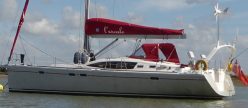Tuesday 25 June
Sailing plans and schedules rarely being in harmony, it was decided to forgo the potential temptations of Douarnenez, in the opposite corner of the bay, and instead make our way directly to the Southern section of this coast’s fierce tidal race, the Raz de Sein. Once again we found ourselves joining a flotilla, with some familiar names popping up on AIS, including Loose Goose, that we’d seen around Brest and before, and our sister ship, Midnight Sky, once again.
The log records the weather as “warm and sunny – T-shirt and shorts!!!” – at last. The reality of such lovely conditions is that there is often barely enough wind to sail, but we did turn the engine off for a while, set the full mainsail with both genoa and staysail up front, and BobbyCool was put to work to steer us by the wind, while trusty Jeanny took a nap. Yes, at last we were putting the new, expensive and bulky-on-the -back-step WindPilot through its paces. It’s actually very easy to set up – even Mate understood the physics – and as long as the sails are set correctly and the boat is well balanced, it is very reliable at holding a course set relative to the wind. Of course, the on-watch crew must still monitor wind shifts, to ensure the correct course is maintained.
As with the Chenal du Four, the fearsome reputation of the Raz de Sein turned out to be something of an anti-climax, and before we knew it, we were crossing the Baie d’Audierne – dipping our toes into the equally nervously anticipated Bay of Biscay, or in French Le Golfe de Gascogne. The day was clear and sunny, with a lazy, long gentle Atlantic swell, but not enough wind, so in went the foresails, and driving was handed back to Trevver and Jeanny: the Es team – engine and electronics.
Meanwhile the crew was entertained by two separate dolphin visits, three before lunch and two afterwards, playing in the bow wave. Guarded by the mighty Eckmühl Lighthouse, we rounded the Pointe de Penmarc’h in the early afternoon, in the company of a large pod of dolphins and their attendant gulls and gannets feeding off the spoils. For a while we flew the genoa again, but the wind soon dropped. At 1630 we crossed the track of the local fishing fleet returning with the day’s catch to Guilvinec, a small but busy landing port; we managed to stay out of their way. In French ports it is common for the day’s catch to be sold in evening markets, and eaten that night for maximum freshness. Shellfish is usually purchased still alive: from the sea to the table in the shortest possible time.
The sky was filling with high cirrus cloud, signalling the leading edge of the next weather front coming in. As the forecast was good, we decided to head straight for the French Caribbean, namely the archipelago of the Iles de Glénans.
